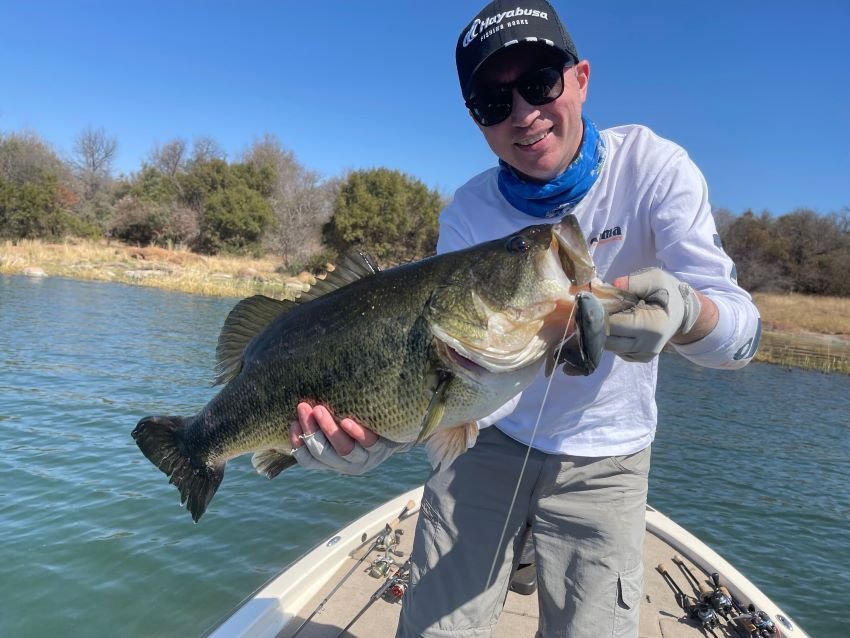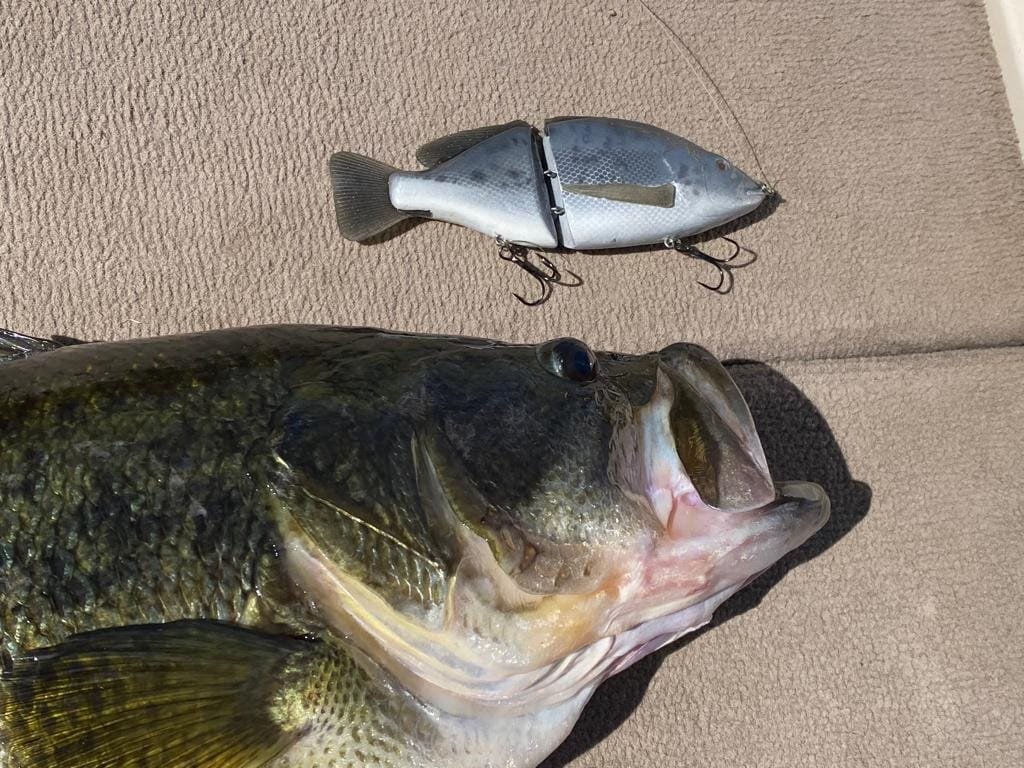South African Big Bait Theory With Duncan Murfin
When Hanna and I went to Africa in the fall of 2016, we had one night in Johannesburg at the end of our trip and our good friend George Robey went more than the extra mile to make it a great evening out. He gathered a “who’s who” of personalities from across the African bass fishing scene for an outstanding dinner. There were tournament directors, anglers, writers and industry reps, and they were all beyond hospitable, but one who stood out was the youngest of the bunch – Duncan Murfin, then an editor of the country’s leading bass magazine. He knew not only everything about his continent’s bass culture, heritage and angling, but also seemingly all sorts of minutiae about the American scene, too – so much so that I was a little afraid he was more attuned to it than I was.
Since that time, Duncan and I have stayed in touch via social media, and while he’s changed jobs he’s moved upward within the fishing industry. As I got ready for the Swimbait Universe Gathering, we ramped up the talk of big baits and he let it slip – he’d been one that imitates a tilapia. That was of particular interest to me because of my frequent trips to Mexico, so I pushed him to give up the goods. Not only was he willing to talk about his own lure, but he also provided thoughts on swimbait culture as it relates to him and to Africa more generally. Here are his opinions, in his own words:
HPFC: What made you decide to get into fishing/building swimbaits?
Murfin: The sheer lack of availability of glides on our local market and imports were scarce and costly. When the S-Waver started to gain popularity back in 2016/2017 including shipping it would have worked out in the region of $80 a bait, so I figured why not learn how to build my own. It started out pretty crude, creating a master from clay and MDF board cutouts of a profile, like kids build toy dinosaurs and then I sculpted over it modelling clay, which totally sucked. I ended up going the cheat route and learning how to us CAD and 3D printing mold masters before casting my own versions.
HPFC: Is there a vibrant swimbait community in Southern Africa?
Murfin: It’s still very much in its infancy but its growing, when the Storm Arashi came out, I think it exposed a lot of anglers to glide baits but by a Fluke standard (probably the most popular bait in the country) it was giant. One limiting factor to the growth of swimbaiting is the lack of rods on the market and you either get find rated under 2-ounces or on the other extreme up to 12oz Muskie rods.
HPFC: How did you build your knowledge base?
Murfin: Guys are tight lipped, so most of what I learned has been from personal experience on how fish behave with a big bait and one or two locals willing to share info. I might have read every post on Swimbait Underground and if there is a glide video on the internet, I think I’ve watched it.
HPFC: Are there any big baits you’ve previously used successfully?
Murfin: Mostly Savage Gear’s range of glides, and some of the bigger 6-7.8” Keitechs.
HPFC: Why are your region’s bass particularly vulnerable to swimbaits?
Murfin: They just haven’t seen that many big baits that react like an oversized jerkbait but that doesn’t make them easier to catch, purely because of the pressure our small lakes receive. We are however discovering that bodies of water that anglers didn’t think have trophy sized fish are home to some absolute giants.
HPFC: What are the primary forage that you’re trying to imitate?
Murfin: Tilapia (Niloticus, Blue Kurper, Redbreast Kurper and Vlei Kurper) are the most widely distributed baitfish across Africa, and although they form part of a bass’ diet they develop a hate relationship once male tilapia get bigger than the palm of your hand, so big bass who can fit them down their throats destroy them.
HPFC: What was the process of building your bait?
Murfin: I’m an absolute stickler for detail and doing the homework, so the whole project began by determining what the most widespread species of Tilapia was, finding live specimens and then documenting the top, front and side profile. I spoke to a few ichthyologists and a friend of mine, Guy Paulet, who is a fisheries manager before starting. I then managed to find a hatchery with sexually mature Blue Kurper females, so that there would be no variation in brood characteristics and colouration. From what I gathered females also make up a higher percentage of the population. One thing that was very clear from early on was that creating an anatomically correct copy of Kurper likely wouldn’t swim or work well as a bait. If you look at them from the top they are teardrop in shape with a broad head and a tapering tail, which posed two problems you wouldn’t be able you to get enough lead into the tail, to balance out the head and a very tall body doesn’t want to glide as smoothly, it kind of rolls so it’s a fine balance between figuring out the right profile and action, or at least for me it was.
HPFC: Did you have any experience building or painting before this?
Murfin: Other than customizing cranks with marker pens and nail varnish, not really. I come from a creative background so picking up the techniques were only slightly less challenging. There is so much science that goes into each step from getting your resin ratio dialed in, to the different chemical interactions to avoid, let’s just put it this way in my first 6 months I ruined more baits and wasted more raw materials than I care to admit. There are zero shortcuts, and every aspiring bait builder will pay their school fees in one way or another.
HPFC: Why a single-jointed glider vs a multiple-jointed lure?
Murfin: I think both have their place, but a single joint just lends itself to a better swim action when imitating a Tilapia, like Bluegill they have a tight swimming action and when chased by a predator or spooked they push off to the side similar to what a glide delivers, but you can only achieve that with a tighter joint configuration. If you’ve ever watched bass hunting a wolf pack of them, they aren’t as agile as longer minnow species.
HPFC: What is the size of your lure and what does it weigh?
Murfin: It measures just on 7-inches including fins and weighs 4oz so you need a dedicated big bait rod to throw it. I’ve equipped them with the smallest and lowest profile hooks available locally, the Hayabusa TBL 930 NRB in size 2. I know what most guys are thinking that they’re too light, but they tuck into the body perfectly, so they offer that ultra-natural profile. Up until now we’ve boated fish up to 11 lbs on them and they’ve been solid. You will bend the back treble on occasion when they get stuck into the side of a fish, but I just replace them, hazard of the application, I guess.
HPFC: How did you know you were on the right track?
Murfin: I’d caught a few fish up to 8 lbs on a rickety prototype that had oversized screw eyes from Lure Parts Online so there was nothing subtle about it. It wasn’t until I’d finished the process and painted one to see what it would deliver. The first fish on a completed bait went 10.5lbs and I caught her from one of the most pressured areas on a local lake we fish. I was out on a work shoot and we pulled up onto the outside edge of a spawning pocket, I bombed a long cast between two visible boulders on a sloping bank at about 8ft deep, (I think it was only the second or third cast ever with the bait) and the fish darted out of the pocket she was in and hit it twice before headshotting it on a pause and quarter turn of the reel. Watching that fish lose its mind on the bait was like nothing I’d ever seen before, and it was pretty much the confirmation I need to key me in that I was doing something right.
HPFC: What are some of the key design elements of your lure?
Murfin: The first thing most guys notice are the soft fins, they’re sort of a hybrid between a bass’ fin configuration and that of a Tilapia. A Tilapia’s dorsal is quite prominent that extends all the way to the tail, something very challenging to achieve with a soft fin plus it would affect your hookup ratio if they had to eat the bait from the side. Hence the reason I designed to have a low key profile that still collapses when they do hit it. I also managed to figure out how to increase the length of the glide by adjusting the hardness of the urethane tail which instead of having a super tight action still has a long glide for the profile.
HPFC: What is the best way to fish it?
Murfin: Slow, you have to cast it out and let it get down, it falls at about a foot every 2.5 – seconds depending on the hooks and once it’s in the zone I like to reel in for a bout 5-6 turns and then give it two quick quarter turns to get it to kick out and come back and then repeat the process. You have to be patient, but we’re only just discovering it best application.
HPFC: Do you have a preferred rod/reel/line?
Murfin: 7’6 XH Glide Rod, 16LB Gamma Edge Fluoro on a 7.2:1 ratio 200 sized Shimano Chronarch
HPFC: What body or bodies of water are you most excited to test it on?
Murfin: The lake that holds the current South Africa Record, Loskop Dam and a dam across the border in Botswana, Letsibogo Dam. I’ve caught PB’s at both and they have each produced fish over 14 lbs on swimbait. What excites me about them is that they are so vastly different one is an ultra-clear deep-water fishery and the other is stained and filled with timber, which is a lot more of that close combat style fishing. They also likely have fish pushing 18-20 lbs in them thanks to their super long growing seasons, incredibly mild winters and they’re packed with forage.
HPFC: Does the lure have a name?
Murfin: Currently its name is the TLP-180, I named my initial design file that and it stuck. As for a brand, I’m still playing with a few ideas but you’ll be the first to know once I get it solidified.
HPFC: Will they be for sale?
Murfin: Hopefully at some point, they’re really fun to fish, we’re at the third generation of prototypes and I finally have a duplicable recipe to consistently get their swim action, right now it’s the paint and final finish that needs to be refined. I’d want anyone who buys a bait one day to have the best experience possible in terms of build quality and because we don’t have access to all the “good stuff” in terms of raw materials it’s taken just a bit longer.








